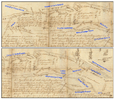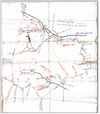Let me just say up front that I am new member of this forum and not a local, and that my overall knowledge of the NJ pine barrens is limited. I should also note that my interest in this specific topic is less geographic than it is genealogical. I am a 6th generation descendant of the German immigrant Sebastian Woos/Woas, who built Shane’s Castle in the area that is now Pestletown in the mid-1700s. My research into him and his family produced a two-part article published in the May and Sep 2023 issues of the
Genealogical Magazine of New Jersey. It dispels many of the long-standing myths about this family. If anyone is interested I am happy to provide a copy. In the course of my research I did explore some geographic topics, and I thought this would be a good forum to share them and get feedback from local experts. One topic is the location of the Woos Burial Place (referred to by several 19th century historians such as Prowell, Clement, Stewart and Heston). I am quite certain I have located it in a spot west of Pestletown Road on the north side of Clark’s Branch, but that will be the subject of a separate post. The other topic is the origin of the name of Pestletown. My theory and the evidence to support it are offered below.
The earliest reference to Pestletown I have found to date is on the front page of the 8 Aug 1879 issue of the
Camden Daily Post in an anecdotal article describing the courtship of a young lady under the heading “Pestletown” in the “Camden County News” column. The name must have been common enough at that time that the article includes no further description of the location. Another early reference is a 27 Nov 1880 note on p. 3 of the
Camden County Courier that reports a child’s burial “in the Catholic cemetery of consecrated ground at Pestletown (that would be today’s Waterford Memorial Park, a separate cemetery from Woos Burial Place). Later that decade a 14 Nov 1887 front-page
Camden Daily Post article describes Pestletown as “a small hamlet of five houses, one of which is vacant.” So, the area was referred to as Pestletown by at least 1879 and probably earlier. That name was certainly common enough to appear on USGS and NJ state topo maps of the area by the mid-1880s, and was fairly frequently mentioned in Camden newspapers of that era (at least 32 mentions between 1879 and 1899). But what is the origin of the name?
The earliest origin story I have found is in a 5 Oct 1933 article by Henry Charlton Beck on p. 6 of the
Camden Evening Courier: “Questions in the vicinity concerning how Pestletown got its name indicated that it is of Indian origin. There is a Pestle brook in the neighborhood and unquestionably that dubbing came from the well-known Indian utensil. Some of those we saw [said] that there were people named Pestle when the town was carved around and from the Garwood farm.” On p. 219 of his book
More Forgotten Towns of Southern New Jersey (1937) Beck repeats this story in a bit more detail and also adds the opinion that the naming of the town after a Pestle family “is doubtful” (on that account he is probably correct as my research has uncovered no “Pestle” families living in this area).
However, my theory partly supports the latter claim, though I think that the name comes not from a family but an individual. That name would be Peston, and I believe Pestletown is a variation of that name. If you have read William Farr’s
Waterways of Camden County (2002) you may be familiar with his entry on Clark’s Branch starting on p. 34 which says it has been variously called in maps, deeds, etc. Woas Branch, Nields Branch,
Pestons Branch, O’Neals Branch, Neals Branch, Hedgehockounk, Briants Branch, and Cripps Branch. He cites an 1844 deed in which Mary Neild (a granddaughter of Sebastian Woos) quitclaimed a portion of land on “the South side of Oneals or Pestons Branch” (Camden County deeds A:108; see also A:109). An even earlier 1833 survey copied in John Clement’s unpublished book “Maps and Draughts, Vol. 4” (p. 65) calls the waterway “Peston’s Branch or Clarks Branch” (see
www.westjerseyhistory.org/surveys/Clement/M&D4.pdf). Farr also cites an 1856 deed that describes land located “on a branch called Woas, formerly Cripps Branch” between “Contine Chew’s [land] and Peston Town” (Camden County deeds 45:520). Note that my quotes are from the deeds, not from Farr. Clement also referred to it as “Pestentown” in the mid-1880s (see below), suggesting that the use of Pestontown may have overlapped the use of Pestletown. Interestingly, a foreclosure/land sale announcement appearing in five weekly issues of the
West Jersey Press in June and July 1864 (see description of the 3rd lot) uses the name “Pestoltown” (is this a typo or does it reflect the beginning of the transition from Pestontown to Pestletown?). In any case, these examples show that the area was referred to as Pestontown by the mid-1800s, probably before it was called Pestletown. That suggests to me that Pestletown is a derivation of Pestontown. But what then is the origin of Peston?
In unpublished notes compiled in the 1880s, Camden County judge, surveyor, historian and genealogist John Clement writes that “Sebastian Woas was sometimes called “Peston,” for what reason is not known” (Clement, “Notes, Memorandas and Incidents of Local History, Families and Settlements in Camden County,” p. 111). On another page of this notebook, Clement describes the location of the Woos family cemetery under the heading “The Grave Yard at Pestentown” (p. 169). In another notebook he repeats the claim that “Sebastian Wooas was sometimes called “Peston” – why does not appear” (Clement, “Births, Deaths and Marriages Taken from Various New Jersey Records,” p. 138). Digital copies of these notebooks can be found in the Family History Library database at familysearch.org under identifiers 2856386 and 2856372 respectively – use those numbers in the keyword search field. As to why Sebastian was sometimes called Peston, I have no idea. The word does not appear in German dictionaries online, though it could be old German. It may just be some form of nickname. Maybe someone else here could venture a guess.
Bottom line: I believe the name Pestletown derives from Pestontown, which in turn originates from the name Peston that was used by or given to Sebastian Woos/Woas who first settled the Pestletown area and built Shane’s Castle there about 1760.
I apologize for the length of this post, but wanted to share everything I know. I hope those of you with local knowledge will weigh in with any other information or opinions.


 That little cemetery lot seems to have merged with lot 13 on your map.
That little cemetery lot seems to have merged with lot 13 on your map.
